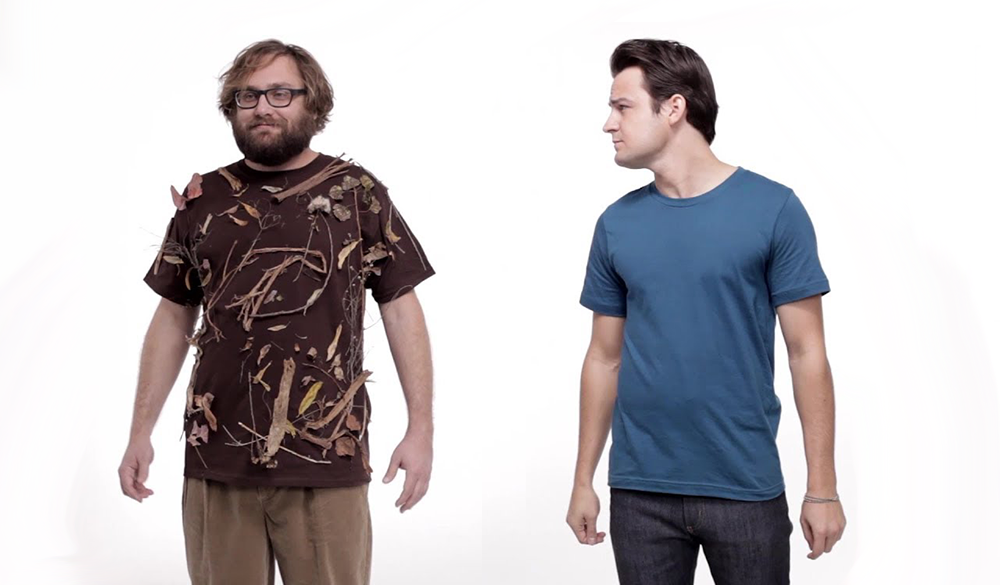We seem to have the same debate with each new customer. What to choose.. Budget / Carded Open-end Tee, or the Retail Ready / Ringspun Cotton Tee. Well, lets try to clear this up for you a bit…
Open-end spinning, is a system of spinning where the yarn is twisted by rotating (the fibers wrap around the yarn v. spinning one long piece of yarn). Carded open-end cotton is a cheaper way of turning cotton into yarn. Up close carded open end fiber is bulky, fuzzy and creates an uneven knit. Currently used in most of your budget apparel. Example: Gildan 5000 / 8000 / 2000. These tend to be sold for fundraisers, band merch, work shirts, and one time use events.
PROS: Cheap, Budget friendly.
CONS: Rougher to the touch. Rougher printing surface.
Ring-spinning, is a system of spinning using a ring and traveler take-up, twists and winds the yarn simultaneously and continuously. Ringspun cotton offers two main advantages: strength and softness. Because the ring-spinning process twists the cotton fibers together to hold the fiber bundle together, ringspun cotton is more durable than open-end cotton.
PROS: Stronger fabric. Soft to the touch. Better for printing on. Holds up better after washing. Fashion forward.
CONS: More expensive. Tends to run small (not true to size. this depends on the brand)

The industry standard used to be a Carded Open-End tee, but nowadays many brands are carrying Ringspun Cotton. As people become more educated about the fabric that makes up their apparel, we see customers moving out of that Carded Open-end and into Ringspun.
What you should take away from this is, What are you ordering these shirts for? If you starting a clothing line and want a quality shirt, or a school making spiritwear that you want the students to wear over and over, Then a Ringspun Cotton Tee may be best for you. If you are doing a fundraiser to raise as much money as possible for your friend, or ordering shirts for your lawn care employees, you may want a budget friendly Carded Open-end cotton Tee.
They are both good shirts. There is no Good or Bad, it just depends on what your needs are. A lot of info on ringspun tees is coming directly from the ringspun tee manufacturers, so you need to understand they are a bit biased. But… We know from experience that printing on ringspun is better. They are a much softer tee, and tend to hold up better after washing. What we have noticed with most fashion brands though is that the ringspun tees tend to me smaller in size. So if you are normally a XLarge tee, you may need to get a 2XLarge. There are still a ton of customers who prefer the “standard” fitting tee. For example, young touring bands like the Gildan tees because they are cheap. They can get the tees printed as cheap as possible, and make what money they can for gas and food. One thing I try to make clear for our customers is that their goal is to get that shirt worn as many times as possible. They are a walking billboard for your company. If you purchase a softer, more flattering shirt, it will get worn more. If you buy the scratchy, rough budget tee, it may spend a good amount of time in the closet. Like I said, its all personal preference. Use what you like.
Here are some shirts we recommend checking out:
Budget / Carded Open-end:
Gildan 2000 (100% Cotton Tshirt)
Gildan 8000 (50/50 Blend Tshirt)
Jerzees 29M (50/50 Blend Tshirt)
Bayside BA5100 (100% Cotton Made in USA Tshirt)
Retail Ready / Ringspun Cotton:
Bella Canvas 3001 (100% Cotton Tshirt)
Next Level 6200 (50/50 Blend Tshirt)
Next Level 6010 (Tri-Blend Tshirt)
American Apparel 2001 (100% Cotton Made in USA Tshirt)
If you are into Ringspun tees, check out some of these clever videos from Bella Canvas about this subject:

